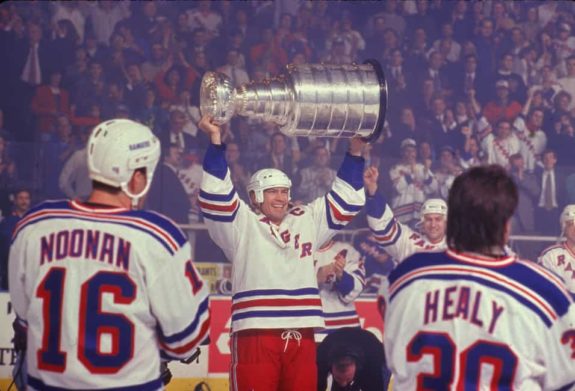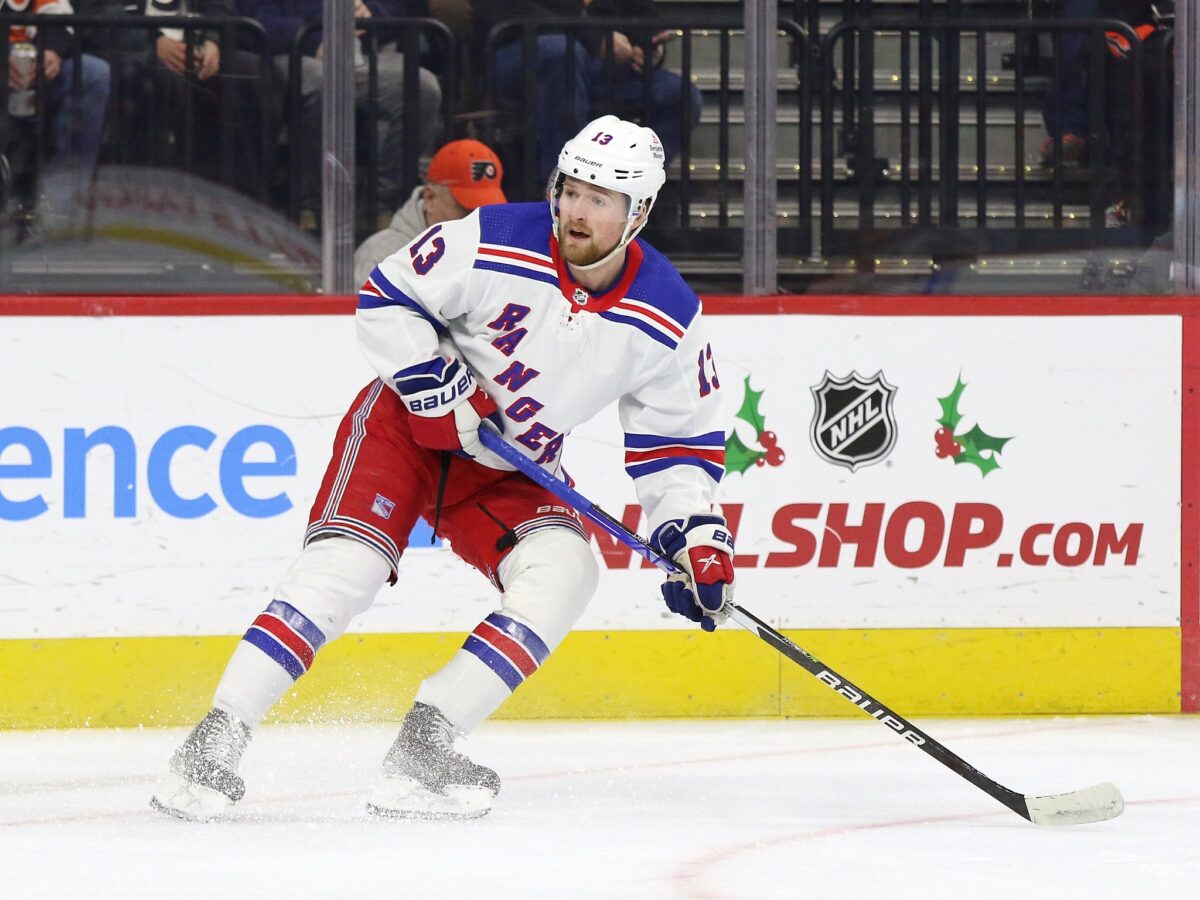The New York Rangers show similarities to the 1990s Detroit Red Wings. Both teams had and have deep prospect pools with a tough lineup to crack. So far during the 2020s, the Rangers have made the playoffs twice, with one of those instances being the “COVID” or “bubble playoffs”, where extra teams were allowed to participate in a play-in round in which the Blueshirts made a quick exit. However, they did make it to the 2022 Eastern Conference Final before losing to the Tampa Bay Lightning.
1990s Red Wings, 2020s Rangers Comparisons
The 1990s were fruitful for the Red Wings. In 1996-97, they were able to finally break through and win their first Stanley Cup since 1955. Plus, they won another the following season.

The Rangers are looking to win the Stanley Cup for the first time since Mark Messier, Brian Leetch and Mike Richter led them to a championship in 1993-94, and that was their first Cup since 1939-40. Both teams have a diverse mix of veterans carrying the team and a core of younger players looking to make their mark.
Breaking Down the Red Wings’ Rise to the Top
Heading into the 1990s, the Red Wings drafted Mike Sillinger, Bob Boughner, Nicklas Lidstrom, Sergei Fedorov, Dallas Drake, and Vladimir Konstantinov in the 1989 NHL Entry Draft. Those picks helped solidify star power and depth for the organization in the decade to come. That draft class ended up playing about 6,000 combined games in the NHL, which is pretty much unheard of, and the bulk of it was spent with the Red Wings.
In the 1990 Draft, the Red Wings took Keith Primeau, Vyacheslav (Slava) Kozlov, and Jason York in the first, third and seventh rounds, respectively. Primeau played six seasons with Detroit and was dealt with Paul Coffey to the Hartford Whalers, bringing Brendan Shanahan into the fold. Shanahan was seen as one of the final pieces to get the Wings over the Stanley Cup hump.
Kozlov also played a significant role in the Red Wings’ back-to-back championships in the 1990s, being part of the famed “Russian Five.” York was a formidable minor leaguer with their American Hockey League (AHL) affiliate the Adirondack Red Wings, but with the loaded roster wasn’t able to find a regular spot in the NHL until he went to another team. He was traded along with Sillinger in a move that brought renowned tough guy Stu Grimson over to Detroit. However, he didn’t factor into the Red Wings’ Cups.
The following year the Wings drafted Martin Lapointe in the first round, Jamie Pushor in the second, Chris Osgood in the third, and Mike Knuble in the fourth. Lapointe and Osgood were key pieces of their core for a good decade, while Pushor and Knuble were each part of their back-to-back Cup-winning rosters.
The 1992 NHL Entry Draft saw the Red Wings select Darren McCarty from the Ontario Hockey League’s (OHL) Belleville Bulls in the second round and Dan McGillis in the 10th. McCarty became a fan favorite and scored the Cup-winning goal when the Red Wings beat the Philadelphia Flyers in the 1996-97 Final. McGillis had a long NHL career playing for several teams; however, he never suited up for the Red Wings. He was traded to the Edmonton Oilers for Kirk Maltby around the 1996 Trade Deadline. Maltby was another cog in the Red Wings’ back-to-back Cup runs and beyond.
In the 1993 Draft, the Red Wings chose Anders Eriksson with their first pick. He helped contribute to the Wings’ 1997-98 win and left the team to play for the Chicago Blackhawks after the 1998-99 season.
Related: Rangers Need Playoff Growing Pains to Reach Full Potential
The Red Wings then drafted Mathieu Dandenault and Tomas Holmstrom in the 1994 Draft. Dandenault went in the second round, and Holmstrom was taken in the 10th round. Dandenault played nine seasons with the Wings, including the 1996-97 season, but didn’t play in the playoffs that time around. However, he did see action in the 1997-98 Playoffs, while Holmstrom spent his whole career in Detroit, playing over 1,000 games. He only dressed for one playoff game during their first championship run but played a major role in their second Cup win during the 90s.
Rangers Building the Same Way
The Rangers reached deeper into the playoffs than anyone expected last season, and the experience they received winning a couple of seven-game series’ was invaluable. Plus, losing in the Eastern Conference Final to the two-time defending Stanley Cup champions was a learning experience as well. Recently, the Rangers have had a slew of high-end draft picks and added top-level prospects to their stable similar to the 1990s Red Wings.

There’s also a logjam or wealth of young talent, with Alexis Lafreniere, Kaapo Kakko, Vitali Kravtsov, Nils Lundkvist (traded to the Dallas Stars for draft capital), K’Andre Miller, Braden Schneider, and Zac Jones all in their early 20s; plus top prospects Will Cuylle, Brennan Othmann, and Adam Sykora in the pipeline. The latter two will represent Team Canada and Team Slovakia at the 2023 World Junior Championship (WJC).
Playoff Growing Pains & Drury Can Bring in 1 or 2 Like Shanahan
The Rangers have built an excellent stable of high-end prospects and young players with a bright future; they also have a core group of veteran leaders. However, they’ll need to go through a few more playoff battles and likely more heartbreak before getting to the promised land. But, if the 1990s Red Wings are any indication, a Stanley Cup could be in the very near future. Plus, president and general manager (GM) Chris Drury has a surplus of young talent that can be utilized on the ice or to help bring in more experienced high-end players in the mold of Shanahan to bring the Cup back to Manhattan.
